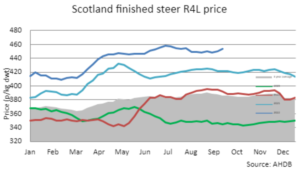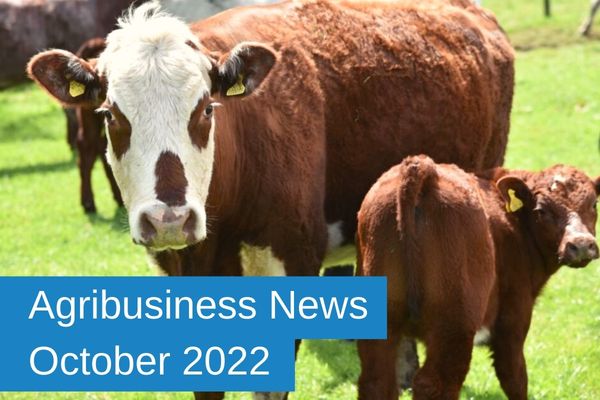Agribusiness News October 2022 – Beef
30 September 2022Cattle prices hold strong
Despite a drop in prices at the start of the month, prices remain at historically high levels, supported by strong global demand and tight supplies. A price drop at this time of year reflects the seasonality as grass-finished cattle and cull cows come online in greater numbers and farmers look towards housing their herds. Prices are sitting around 454p/kg/dwt for R4L steers (+33p in comparison to this week in 2021).
Reports suggest a tightening in supply of cattle numbers coming forward in the next few months, which may result in processors lifting prices. However, despite finishers needing more return (at least to a more sustainable level, and input costs continuing to weigh heavily on businesses, with little sign of feed prices returning to more recognisable levels due to a tighter global supply outlook) retailers will not want to increase retail prices and face consumer resistance.
Cull cow prices remain at record high – despite a downward trend earlier in the month – and continue to be the most lucrative of all beef enterprises. Scottish R4L grade cows are sitting at approx. 400p/kg/dwt with many cows are making well over £1,000 in the live ring, with many farmers taking advantage of this trade. On paper this looks good reading; one farmer recently alluded to his cull cows averaging £1350 – the same price as 2 tonnes of fertiliser. It is these dramatic increases in input costs that are making suckler farmers rethink the viability of their herds.
Processors will soon think towards Christmas and concentrate on building up stocks of prime beef and with the number of cull cows coming through likely to increase ahead of housing, it remains to be seen how price, processor demand, and cow availability balance.
Auction sales
Prices in the store ring remain strong, with Scottish store prices currently being pushed up by English buyers, mirroring what we saw at the spring sales. This will affect supply of finished cattle for Scottish abattoirs. Farmers will be considering what to sell next, with many stores and weaned calves coming into the market in the coming weeks, which may lead to a lesser trade as weaned calves are not suited to everyone’s system. The strong continental types with good confirmation and weights will sell well however lighter longer-term calves, may well be met with resistance from buyers.
Weighing up the cost
Feed and forage calculations for the winter ahead will be taking place on farms soon. Purchased feed is already incredibly higher than last year coupled with the increase in fuel costs adding to delivery charges, this could well lead to livestock numbers taking a hit to reduce the strain on finances. However, care must be taken if reducing or dispersing herds in terms of tax implications, so liaising with an accountant will be important.
Food trends over the past few years have been dominated by the impact of Covid-19 however the cost-of-living crisis is now impacting shoppers as consumers face significant economic challenges. Food price inflation is affecting both retail and foodservice with people eating out less. The crisis leads more price-conscious shoppers to the discount supermarkets e.g. Aldi and Lidl who have plans for opening more stores. The continued strain on shoppers’ budgets is going to have the biggest impact on consumer meat buying behaviour going forward.
Sign up to the FAS newsletter
Receive updates on news, events and publications from Scotland’s Farm Advisory Service



